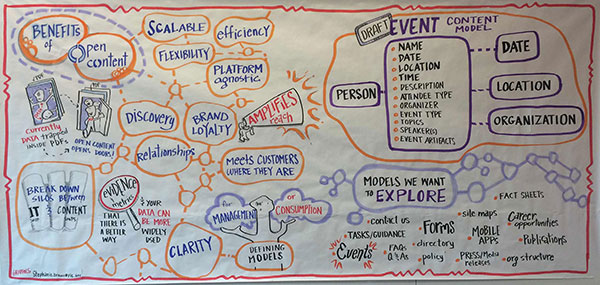What Structured Content Can Do For You: Webinar Recap
Structured content and open content models can help you create content that is platform-agnostic, format-free, and device-independent. This was the theme of the “What Structured Content Can Do For You: Article Model” webinar last month.
[youtube=http://www.youtube.com/watch?v=kG25vyQ5Jps&w=600]
Using a content model is less about how you are crafting your message and more about how the internet is going to react to your content or how you can manipulate it, according to Holly Irving from the National Institutes of Health, Russell O’Neill from the General Services Administration, and Logan Powell from U.S. Census Bureau.
For instance, when you Google iPad reviews, your search results will display some starred reviews. Those reviews are displayed because they use a content model that talks with Google’s algorithms. The content models the working group developed were adapted from Schema.org, whose content models are used by Google, eBay, Facebook and many more. Using this adaptation will increase your SEO due to the metadata associated with it.
Content modeling is essentially a mental model on how to structure your information, said Powell. “When we create an article, our basic units of data are a title, description, the government organization that created the content (source information), topics, and article body. We input this information into our content management system and the meta-tags help us sort, search, and manipulate that information.”
As another example, Irving asked attendees to consider how an apartment manager might provide content on their website. They look at the information they have and identify what their prospects might want to know: price, availability, floor plans, etc. Those chunks of data are what the apartment manager will use to build their content model for their site. Once the model is in place, you can more easily rearrange your content. You do this by rearranging the meta-tags, Irving said. By focusing on those tags it has the potential to rearrange all content so you do not have to go in to every page and make adjustments, she explained.
The poster child for content modeling is National Public Radio, the presenters noted. Once they input their information, it goes through an API and is distributed through multiple platforms. Once in these platforms, those meta-tags help communicate information, which is why on the radio you can see specific information rather than just ‘NPR program.’ When the iPad came out, it took NPR only two weeks to create an app due in a large part to their content modeling. The information was already organized. Structured content liberates your content. It allows you to manipulate it now and later without needing to recreate your page. It makes your content flexible and usable. Structured content enables long-term functionality.
To view the article model and others visit our space on GitHub. Here the working group is building/tweaking models so if you have questions, suggestions, or want to participate, please do.
Kirsten O’Nell is a Social Media Specialist for the Defense Commissary Agency. Want to know more about content models? Join us for our webinar on the Event model this Thursday, June 12th, at 1 pm.


